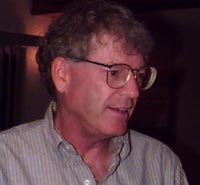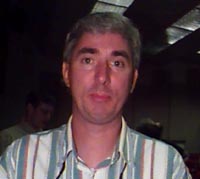Dispatches from the La
Ni
ñ
a
Summit
(Dispatch #2)
Mary K. Miller
July 16, 1998
Boulder, CO.
|
|
Many people have the impression
that scientists are lone wolves, toiling away in the lab or field
until they wrestle a problem to the ground and emerge with an answer.
There's an element of truth to that, but the last two days of the
La Niña Summit show that there's another side to science. The
100 or so men and women who constitute most of the world's leading
experts on El Niño/La Niña came to NCAR this week to
exchange information and ideas, probe, challenge, and sometimes yell
at each other. Yesterday, I heard one researcher roar at another who
questioned his methods; a few hours later they were chatting over
a cup of coffee. The goal of all the debates is consensus, agreement
by most of the scientific community on a set of principles. Consensus
doesn't necessarily mean the scientists are right, just that they're
more likely to be right--until new information or ideas change the
picture. And sometimes the consensus is simply that we don't know
enough yet.
|
|
Some
of Michael Glantz's goals in organizing the conference were for scientists
to reach consensus on what La Niña is, what should be communicated
about it to the public, and what we can expect from the weather this
winter. It doesn't look like the experts agree on those answers yet,
but they're closing in. One of the difficulties of predicting the
weather and climate is that it's always changing and no two years
are the same.
|

Michael Glantz, a social scientist at NCAR (and Milton Berle's
nephew) organized the La Ni
ñ
a
Summit.
|
|
|
Scientists recognized
a developing La Niña last spring when a pool of cool water
starting spreading into the eastern tropical Pacific. From past La
Niña events, they can offer pretty good odds that the Indian
subcontinent, Southeast Asia, and Australia will have heavy or above-normal
rains this year, and that the northern U.S. will have a cold, snowy
winter, while the Southwest will have a warmer, drier winter. But
like every El Niño, every La Niña is different. Scientists
never know from statistics exactly how tropical ocean temperatures,
winds, and pressure gradients create changing global weather patterns.
|
To help them
figure out the causes and effects of weather and climate, many researchers
turn to computer climate models. Computer models, also called coupled
or dynamical models, are the lab rats of the climatology profession.
They allow researchers to perform multiple controlled experiments
with a simulated climate--something they can't do with the real world.
The CIRES computer model--developed by Marty Hoerling and others at
NOAA, the University of Colorado, and other universities across the
county--is state of the art. The computer code in the CIRES model
reconstructs the complex and dynamic interactions that drive our often
chaotic climate, especially the relationship between the ocean and
atmosphere. The model predicts changes in temperature, wind speed
and direction, ocean currents, clouds, rain, heat transfer, and atmospheric
pressure patterns--all the factors that help create weather and climate
on earth. Those model results are compared with observations from
actual climates to ensure that the models are realistic.
|

Marty Hoerling, a climate modeler from the University of Colorado,
is working to tease out the weather impacts of La Nina.
|
|
|
So far, as we heard at the
La Niña Summit yesterday from Tony Barston, a researcher at
the Climate Prediction Center, the dynamical models aren't doing a
smashing job at predicting the magnitude or timing of La Niña
and El Niño events or their apparent effects on long-range
weather patterns. He evaluated models from six different research
groups and only one came close to duplicating the last El Niño.
"The models have a long way to go," Dr. Barston said, and added that
it will probably be another 10-15 years before the models do better
than looking at statistics from the past. But even though the models
aren't perfect, Barston encouraged researchers to stick their necks
out, make predictions, and learn from errors to make the long-range
climate models better.
|
|
One meteorologist who did
stick his neck out (and incidentally lost his job later) was Joe
Friday, former head of the National Weather Service (NWS). During
the height of El Niño last winter, he ran experiments with
the weather models used by NWS to forecast the national weather.
He ran the model with El Ni–o conditions plugged in, and compared
the results with model runs that didn't include El Niño.
When he ran the model with El Niño, it duplicated an ice
storm that struck the northeastern U.S. last February. Without El
Niño conditions, the model didn't produce an ice storm. It
was the first time a researcher definitively tied a specific weather
event with El Niño. Of course, the scientists at the La Niña
Summit hasten to add that not all ice storms can be pinned on El
Niño. Joe Friday's results are very controversial, so maybe
even last February's ice storm can't be blamed on El Niño.
Still, it's possible that some day, in a few years or a few decades,
scientists and their computer models will provide more reliable
and specific information on when El Niño and La Niña
will appear, and how these tropical Pacific conditions affect weather
across the globe.
|
Return to the
La Nina Summit WebCast
/ ©1998
The
Exploratorium
|



